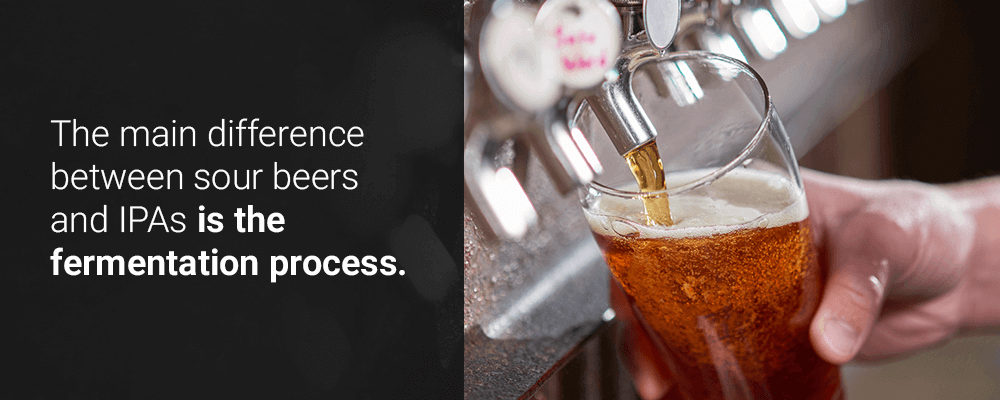Defining Sour Beer
Posted by Johnny Sour on Nov 29th 2021

WHAT IS SOUR BEER?
As its name suggests, sour beer has a distinct sour, acidic or tart taste. Essentially, "sour beer" refers to any beer that tastes especially acidic and lively. By including fruits like raspberry, cherry and peach, sour beers can create the perfect balance of sweet and sour flavors.
Unlike other beers, sour beers use wild bacteria and yeast during the brewing process to achieve a tart, crisp flavor. The microbes most commonly used to create sour beer are the bacteria Lactobacillus and Pediococcus, while Brettanomyces is often used to add acidity. Adding fruit can also give sour beer a more tart taste thanks to the organic acids found in most fruits, such as citric acid.
The wild organisms used to sour beer can bring a wide range of flavors from intensely sour to light and fruity to downright funky. More well-known types of beers use specific yeast strains in a sterile environment to maintain tight control over the brewing process and produce more familiar flavors.
HOW IS SOUR BEER BREWED?
While the brewing process for sour beer varies depending on the type of sour beer being made, these five steps are generally followed across all sour beer styles:
The grain is made: First, the grain must be mashed with malt and water and allowed to rest. Then, the grain bed can be rinsed to pull out as much sugar from it as possible without extracting tannins from the grain husks — a process known as sparging. The grain is sparged until the kettle is full.
- Aged hops are added to the boil: Only a small amount of aged hops should be added to the boil because too many hops could inhibit the growth of bacteria.
- Bacteria is added: After the wort has cooled, the mixture is ready to be transferred to the secondary fermentation vessel, where it will be primed with yeast and bacteria. Bacteria can be added directly or after the wort has been first fermented with the regular brewer's yeast. Cooling the wort slowly in an open vessel and allowing it to ferment and age in a wooden cask will allow the wort to pick up wild yeast and bacteria from its environment to give it a better sour flavor.
- The beer starts to ferment: In the first few weeks, a head of foamy yeast and wort proteins will form and bubble on the surface of the beer. As the wort settles down, a film may also develop on top of the beer to protect the bacteria from exposure to air or harmful substances.
- The fermentation process is completed: Fermenting the beer may take several months or until the desired level of lactic acid concentration and sourness is reached. Afterward, the beer will be ready to bottle and enjoy

- The main difference between sour beers and IPAs is the fermentation process. Sour beers get their sour flavor from the lactic acid produced by the Lactobacillus and Pediococcus bacteria as it ferments. Unlike sours, IPAs are brewed in a controlled setting without wild bacteria and do not have as much of an acidic taste.
WHAT’S THE TYPICAL ABV FOR A SOUR BEER?
While most sour beers are somewhere between 3%-5% alcohol by volume (ABV), some can be as high as 8%-9% or as low as 2%. The ABV of a sour beer depends heavily on the style of sour and the beer's brewing conditions. Because sour beer generally has a lower ABV, most sour beers can be considered a session beer. This includes any beer that is lower in ABV and high in refreshment, so you can enjoy multiple in a drinking session.
WHAT PAIRS WELL WITH SOUR BEERS?
Sour beer tastes great alongside a wide variety of different foods. The uniquely tart flavor of sour beers pairs best with these types of dishes:
- Spicy foods: Anything spicy, like fajitas or chili, complements the tart flavor of sour beers.
- Fatty cuts of beef: The richness of a fatty cut of beef, like a ribeye, goes well with the lighter taste of a sour beer.
- Cured meats: Cured meats and sausage tend to be extremely salty, which makes them the perfect partner for a refreshing sour beer.
- Deep-fried foods: A greasy appetizer like french fries or onion rings needs a light session beer like a sour.
- Strong cheeses: Assertive cheeses, such as goat, sharp cheddar or gorgonzola, often pair well with a slightly fruity sour beer.
- Mollusks: The salty sea taste of oysters, clams and mussels matches nicely with a refreshing sour beer, especially when the seafood is served with lemon juice and butter.
WHAT GLASS SHOULD I USE WITH A SOUR?
Any beer connoisseur knows that glass choice is crucial. Although a sour beer can taste great in a wide variety of glasses, you may want to use a tulip glass to make the most of your sour beer experience. A tulip will allow the brew to breathe, which is key when enjoying a sour, while generating a complex aroma from the head of the beer.
However, a tulip isn't your only sour beer glass option. A sour will still taste great served in a snifter, tumbler or an oversized wine glass. If you order the sour as part of a tasting flight, make sure it comes after any darker or heavier beers so you can end on a lighter note.

